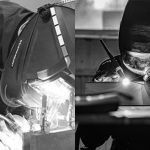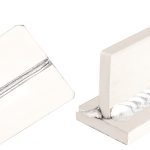Regarding TIG Welding Gas, Pure Argon is still the favorite when it comes to TIG Welding Aluminum, especially for thin applications (less than 1/2 inch).
For thicker base metal (from 1/2 inch), using a mixture of Argon and Helium is highly recommended.
The addition of Helium makes your arc hotter, and thus improves weld penetration.
Depending on the thickness of your aluminum piece, you can choose 25 percent Helium or 50 percent Helium.
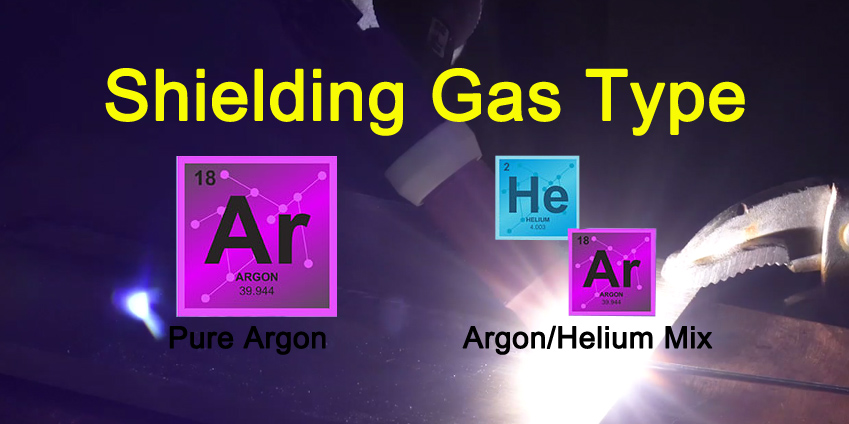
Proper Gas flow
The amount of gas flow is closely related to the cup size that you use.
It is usually based on experience, through many experiments around it.
For reference, for a TIG cup with size 7/16 inch needs about 15 cfh of gas flow.
Or a number 8 cup would require 15 to 20 cfh.
When your cup size drops down to a number 5, you would need only 12 cfh in this example.
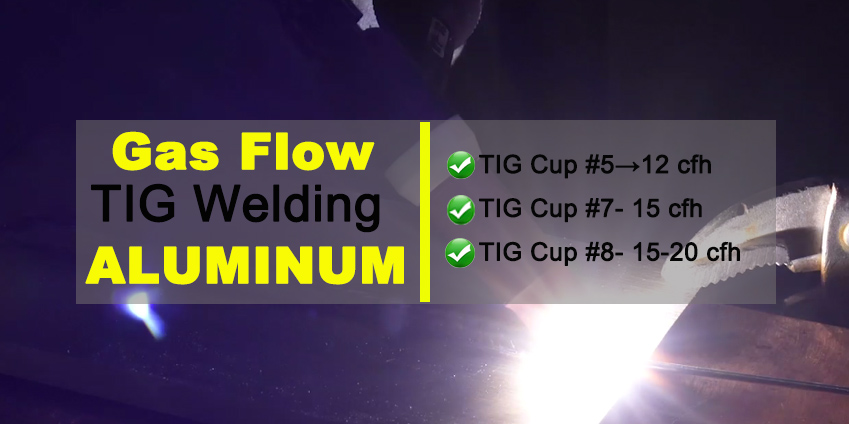
What tungsten electrode to use for TIG Welding Aluminum?
Correct Tungsten Electrode Type
The 2 percent thoriated and 2 percent lanthanated tungsten electrodes can be of good use for TIG Welding Aluminum.
However, between the two, 2 percent lanthanide is more favorable, as it contains no radiation.
This tungsten can perform well on AC and can operate at high amperages.
For TIG Welding Aluminum, Pure Tungsten is NOT recommended.
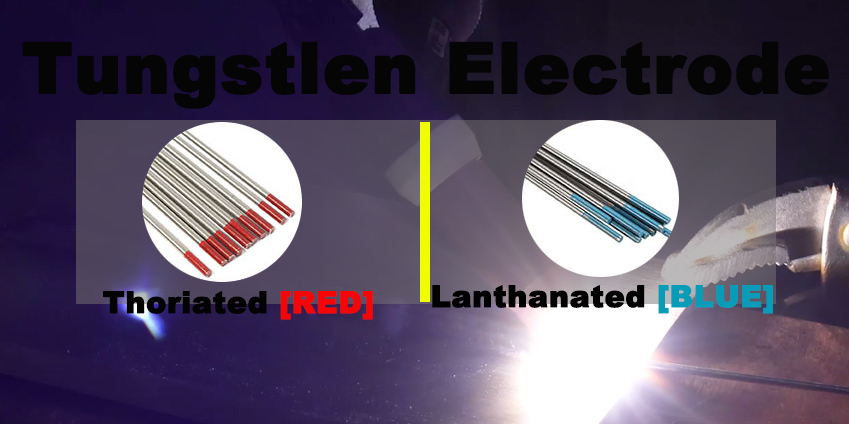
Proper Tungsten Diameter
One common recommendation is to use a 1/8-inch tungsten electrode when working with aluminum.
This tungsten size provides enough heat and can maintain a stable arc throughout your welding session.
Other options when TIG welding aluminum with 2 percent lanthanated electrode include 3/16 inch and 3/32 inch types.
Tungsten Geometry
Regarding tungsten geometry, electrodes with balled tips are suitable.
Usually, this ball should be 1 to 1.5 times the diameter of the tungsten electrode.
Before starting TIG welding aluminum on AC, use reverse polarity (DCEP) to heat the tungsten and form a balled tip.
After having the ball at the tip of the tungsten, simply switch your TIG welder to AC and start your welding session with aluminum.
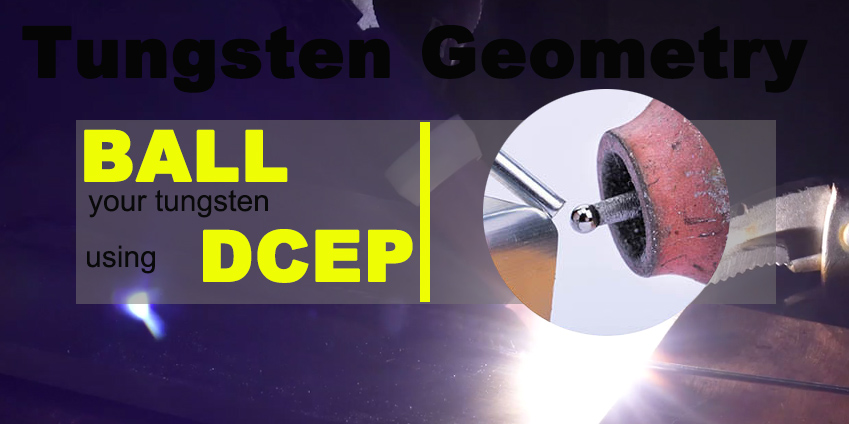
Introduction
TIG welding, also known as tungsten inert gas welding, is a popular technique used for joining metals, including aluminum. One critical aspect of TIG welding aluminum is the selection of the appropriate shielding gas. The right shielding gas not only ensures the integrity and quality of the weld but also protects the molten metal from contamination. In this article, we will explore the various types of shielding gases suitable for TIG welding aluminum, their recommended flow rates measured in cubic feet per hour (cfh), and provide valuable insights to help you make an informed decision.
What Shielding Gas To Use For TIG Welding Aluminum?
When it comes to TIG welding aluminum, the most commonly used shielding gas is argon. Argon gas provides excellent coverage and protection, preventing oxidation and atmospheric contamination during the welding process. It creates a stable arc and helps produce high-quality welds with minimal defects.
The Importance of Shielding Gas Flow
In addition to selecting the right type of shielding gas, the flow rate of the gas is equally crucial. The gas flow rate is measured in cubic feet per hour (cfh) and determines the effectiveness of the shielding gas in protecting the weld zone. Insufficient gas flow can result in inadequate coverage, leading to porosity and other defects in the weld.
Recommended Shielding Gas Flow Rates for TIG Welding Aluminum
To achieve optimal results when TIG welding aluminum, it is essential to use the appropriate shielding gas flow rate. Here are some recommended flow rates for different welding scenarios:
- General TIG Welding: For general TIG welding applications on aluminum, a shielding gas flow rate of 15-20 cfh is recommended. This flow rate provides adequate protection and coverage for most welding tasks.
- Heavy-Duty Welding: In situations that involve heavy-duty welding or thicker aluminum materials, it is advisable to increase the shielding gas flow rate to 20-30 cfh. The higher flow rate ensures better protection and prevents contamination.
- Precise Welding: When performing precise or intricate welds, such as welding thin aluminum sheets or delicate components, it is advisable to reduce the shielding gas flow rate to 10-15 cfh. The lower flow rate allows for better control and minimizes the risk of blowing through the material.
Frequently Asked Questions
Can I use pure argon gas for TIG welding aluminum?
Yes, pure argon gas is commonly used for TIG welding aluminum. Argon provides excellent shielding properties, preventing oxidation and ensuring high-quality welds. It is readily available and widely used in the industry.
Can I use a mixture of gases for TIG welding aluminum?
While pure argon is the most common shielding gas for TIG welding aluminum, there are certain applications where a mixture of gases may be used. For instance, adding a small percentage of helium to argon can enhance the arc characteristics and improve heat penetration, making it suitable for welding thicker aluminum sections.
What are the disadvantages of using the wrong shielding gas?
Using the wrong shielding gas can have adverse effects on the quality of the weld. Insufficient coverage can lead to porosity, brittleness, and reduced strength. Contaminants such as oxygen and moisture can also cause oxidation and result in compromised weld integrity.
How do I determine the appropriate gas flow rate for my TIG welding application?
The recommended gas flow rates mentioned earlier are a good starting point. However, it is always best to refer to the welding equipment manufacturer’s guidelines and specifications for the specific TIG welding setup you are using. These guidelines often provide detailed information on the gas flow rate suitable for various welding scenarios.
Can I reuse the shielding gas for multiple welds?
In most cases, it is not recommended to reuse shielding gas for multiple welds. The gas can become contaminated during the welding process, compromising its effectiveness in protecting the weld. It is best to purge the system with fresh shielding gas before starting each new weld.
Are there any alternatives to argon for TIG welding aluminum?
While argon is the most commonly used shielding gas for TIG welding aluminum, there are alternative gases available. These include argon-helium mixtures, which can offer improved penetration and weld characteristics for certain applications. However, it is essential to consider the specific requirements of your welding project and consult with experts or welding equipment manufacturers to determine the most suitable shielding gas.
Conclusion
Selecting the right shielding gas is crucial for achieving high-quality TIG welds on aluminum. Argon is the preferred choice due to its excellent shielding properties. By adjusting the gas flow rate to suit the specific welding requirements, you can ensure adequate protection and minimize the risk of defects. Always refer to the manufacturer’s guidelines and consult with experts when in doubt about the appropriate shielding gas and flow rate for your TIG welding projects.







